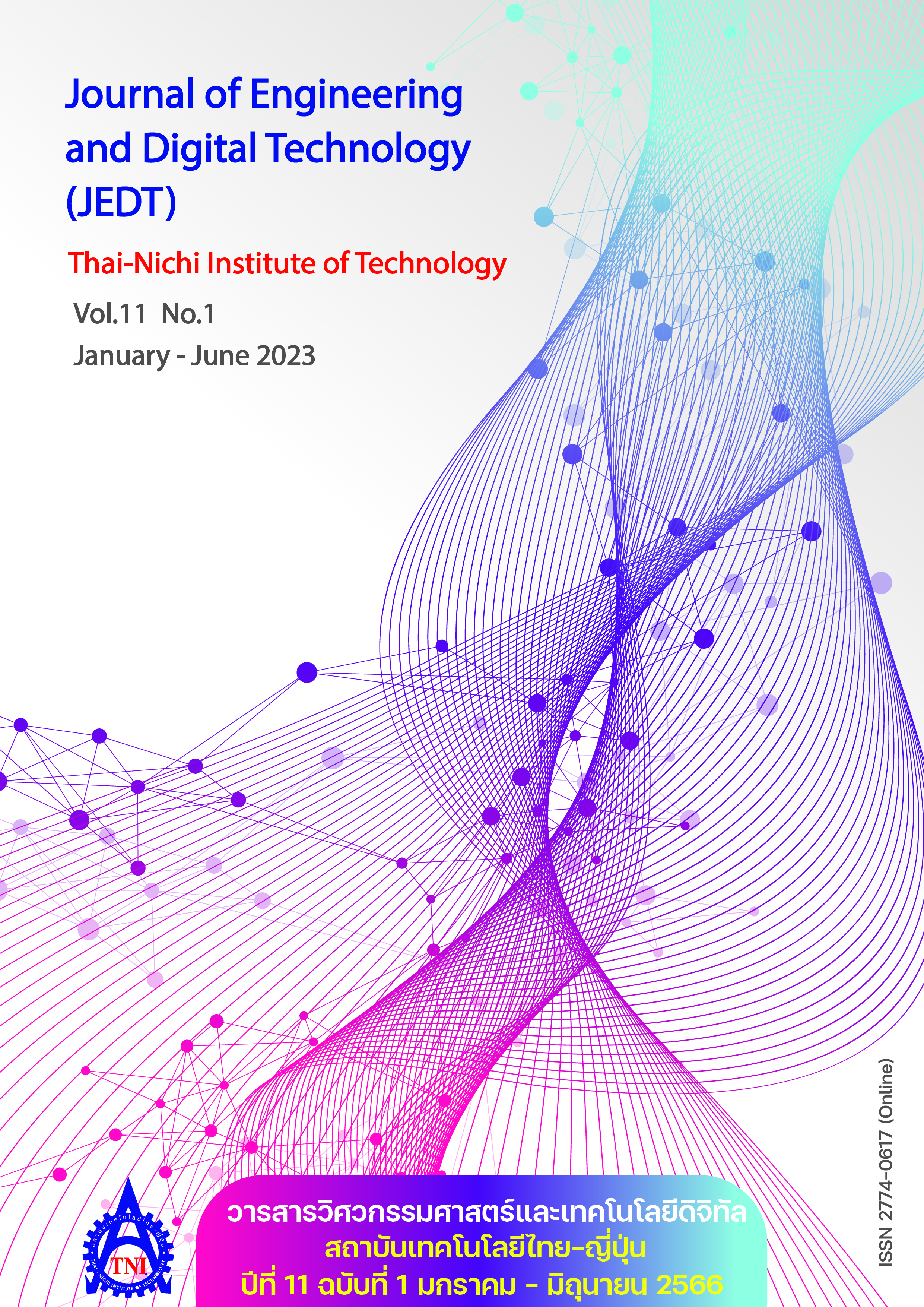การศึกษาความหนาผิวเคลือบที่ส่งผลต่อขนาดที่ปรากฏของรอยบ่งชี้จากการทดสอบด้วยวิธีอนุภาคแม่เหล็ก
Main Article Content
บทคัดย่อ
งานวิจัยนี้มีวัตถุประสงค์เพื่อศึกษาความหนาของสารเคลือบผิวชิ้นงานที่ส่งผลต่อการตรวจสอบด้วยวิธีอนุภาคแม่เหล็ก ตัวแปรหลักที่ทำการศึกษา คือ ความหนาของสารเคลือบ โดยการศึกษากับสารเคลือบผิวชิ้นงาน 3 ประเภท คือ สารเคลือบสีขาว สารเคลือบสี และสารเคลือบแลคเกอร์ ทำการทดสอบกับชิ้นงานมาตรฐานที่จำลองรอยบากร่องขนาดความกว้าง ความยาวและความลึกเป็น 0.0060, 0.0625, และ 0.0200 นิ้ว ตามลำดับ การทดลองดำเนินการทดสอบหารอยบ่งชี้ที่ชิ้นทดสอบที่ไม่ได้เคลือบผิว และชิ้นทดสอบที่ผ่านการเคลือบผิวที่มีระดับความหนาน้อยถึงระดับความหนาที่ไม่สามารถแสดงผลของรอยบ่งชี้ที่ชัดเจน ใช้โย้กเหนี่ยวนำทำให้ชิ้นทดสอบเป็นแม่เหล็ก ขณะเดียวกันฉีดพ่นผงแม่เหล็กแบบเรืองแสงลงตำแหน่งที่ต้องการตรวจสอบ จากนั้นทำการบันทึกภาพด้วยกล้องไมโครสโครปที่กำลังขยาย 30 เท่า ภายใต้แสง UV – A ในห้องมืด ทำการวัดผลจากความยาวของรอยบ่งชี้ที่ปรากฏของแต่ละประเภทของสารเคลือบ
จากผลการทดลอง พบว่า ความหนาของสารเคลือบทั้ง 3 ประเภท มีผลต่อปริมาณความหนาแน่นของสนามแม่เหล็กที่เกิดขึ้นที่รอยบากร่องของชิ้นทดสอบที่ระดับความหนาแตกต่างกัน ความหนาของสารเคลือบที่ส่งผลต่อความหนาแน่นของสนามแม่เหล็กมากที่สุดไปถึงน้อยสุด คือ สารเคลือบสีขาว แลคเกอร์และสารเคลือบสี โดยมีค่าของความหนาที่ส่งผลต่อความหนาแน่นสนามแม่เหล็กเป็นค่า 61.19, 73.63 และ 83.56 ไมโครเมตร ตามลำดับ โดยพิจารณาจากขนาดความของรอยบ่งชี้ที่ลดลงมีค่าเป็นครึ่งหนึ่งของรอยบกพร่องที่ยอมได้ตามเกณฑ์ตามมาตรฐานของ ASME Section V
Article Details

อนุญาตภายใต้เงื่อนไข Creative Commons Attribution-NonCommercial-NoDerivatives 4.0 International License.
นโยบายการรับบทความ
กองบรรณาธิการวารสารสถาบันเทคโนโลยีไทย-ญี่ปุ่น มีความยินดีรับบทความจากอาจารย์ประจำ และผู้ทรงคุณวุฒิในสาขาวิศวกรรมศาสตร์และเทคโนโลยี ที่เขียนเป็นภาษาไทยหรือภาษาอังกฤษ ซึ่งผลงานวิชาการที่ส่งมาขอตีพิมพ์ต้องไม่เคยเผยแพร่ในสิ่งพิมพ์อื่นใดมาก่อน และต้องไม่อยู่ในระหว่างการพิจารณาของวารสารอื่นที่นำส่ง ดังนั้นผู้สนใจที่จะร่วมเผยแพร่ผลงานและความรู้ที่ศึกษามาสามารถนำส่งบทความได้ที่กองบรรณาธิการเพื่อเสนอต่อคณะกรรมการกลั่นกรองบทความพิจารณาจัดพิมพ์ในวารสารต่อไป ทั้งนี้บทความที่สามารถเผยแพร่ได้ประกอบด้วยบทความวิจัย ผู้สนใจสามารถศึกษาและจัดเตรียมบทความจากคำแนะนำสำหรับผู้เขียนบทความ
การละเมิดลิขสิทธิ์ถือเป็นความรับผิดชอบของผู้ส่งบทความโดยตรง บทความที่ได้รับการตีพิมพ์ต้องผ่านการพิจารณากลั่นกรองคุณภาพจากผู้ทรงคุณวุฒิและได้รับความเห็นชอบจากกองบรรณาธิการ
ข้อความที่ปรากฏภายในบทความของแต่ละบทความที่ตีพิมพ์ในวารสารวิชาการเล่มนี้ เป็น ความคิดเห็นส่วนตัวของผู้เขียนแต่ละท่าน ไม่เกี่ยวข้องกับสถาบันเทคโนโลยีไทย-ญี่ปุ่น และคณาจารย์ท่านอื่น ๆ ในสถาบัน แต่อย่างใด ความรับผิดชอบด้านเนื้อหาและการตรวจร่างบทความแต่ละบทความเป็นของผู้เขียนแต่ละท่าน หากมีความผิดพลาดใด ๆ ผู้เขียนแต่ละท่านจะต้องรับผิดชอบบทความของตนเองแต่ผู้เดียว
กองบรรณาธิการขอสงวนสิทธิ์มิให้นำเนื้อหา ทัศนะ หรือข้อคิดเห็นใด ๆ ของบทความในวารสารสถาบันเทคโนโลยีไทย-ญี่ปุ่น ไปเผยแพร่ก่อนได้รับอนุญาตจากผู้นิพนธ์ อย่างเป็นลายลักษณ์อักษร ผลงานที่ได้รับการตีพิมพ์ถือเป็นลิขสิทธิ์ของวารสารสถาบันเทคโนโลยีไทย-ญี่ปุ่น
ผู้ประสงค์จะส่งบทความเพื่อตีพิมพ์ในวารสารวิชาการ สถาบันเทคโนโลยีไทย-ญี่ปุ่น สามารถส่ง Online ที่ https://www.tci-thaijo.org/index.php/TNIJournal/ โปรดสมัครสมาชิก (Register) โดยกรอกรายละเอียดให้ครบถ้วนหากต้องการสอบถามข้อมูลเพิ่มเติมที่
- กองบรรณาธิการ วารสารสถาบันเทคโนโลยีไทย-ญี่ปุ่น
- ฝ่ายวิจัยและนวัตกรรม สถาบันเทคโนโลยีไทย-ญี่ปุ่น
เลขที่ 1771/1 สถาบันเทคโนโลยีไทย-ญี่ปุ่น ซอยพัฒนาการ 37-39 ถนนพัฒนาการ แขวงสวนหลวง เขตสวนหลวง กรุงเทพมหานคร 10250 ติดต่อกับคุณพิมพ์รต พิพัฒนกุล (02) 763-2752 , คุณจุฑามาศ ประสพสันติ์ (02) 763-2600 Ext. 2402 Fax. (02) 763-2754 หรือ E-mail: JEDT@tni.ac.th
เอกสารอ้างอิง
The Welding Engineer’s Current Knowledge, GSI SLV, Duisburg, Germany, 2015, pp. 23–25.
B. Modiri, P. M. Mohammad, Y. Mojtaba, S. Hossein, S. O. Farzin, and A. Alireza, “Stochastic lifetime estimation of pressurized gas pipeline; Case study of the urban gas pipeline,” Int. J. COMADEM, vol. 20, no. 2, pp. 31–37, Apr. 2017.
J. T. Schmidt and K. Skeie, “Dry power magnetic particle tests of painted welds,” in Nondestructive Testing Handbook, 2nd ed. Columbus, OH, USA: American Society for Nondestructive Testing, 1989, pp. 386–387.
Y. Wang, X. Gao, M. Finckbohner, and U. Netzelmann, “The effect of paint coatings on detection of vertical surface cracks in metals by induction thermography,” NDT & E Int., vol. 104, pp. 58–68, Jun. 2019.
A. Keresten, S. Ostanin, and V. Zuev, “Advanced liquid epoxy and polyurethane materials: internal and external coatings for pipeline and tubing protection,” E3S Web of Conf., vol. 225, Jan. 2021, Art. no. 05004.
Non-destructive testing of welds — Magnetic particle testing, ISO 17638:2016, the International Organization for Standardization, Switzerland, Oct. 2016.
Parker Research Corporation. NA-16 Notch Defect Test Bar. (2023). Accessed: Dec. 28, 2022. [Online]. Available: https://www.parkerndt.com/product/na-16-notch-defect-test-bar/
Magnaflux. WCP-2 White Contrast Paint. (2023). Accessed: Mar 13, 2023. [Online]. Available: https://magnaflux.eu/EU/EN/Products/Magnetic-Particle-Inspection/Consumables/WCP-2.htm
TOA Groups. Technical Data Sheet. (2017). Accessed: Mar 13, 2023. [Online]. Available: https://www.toagroup.com/storage/downloads/technical%20data/hardware/spray/toa/tds-toa-flat-white-primer-spray-65.pdf
TOA Groups. Technical Data Sheet. (2017). Accessed: Mar 13, 2023. [Online]. Available: https://www.toagroup.com/storage/downloads/technical%20data/hardware/spray/toa/tds-toa-automotive-spray.pdf
A. Prateepasen, Magnetic Particle Testing: Non – Destructive Testing in weld and research, 7th ed. Bangkok, Thailand: Chulalongkorn University Press (in Thai), 2014.
C. W. Eick, “Electrically Inducing Magnetism,” in ASNT Level II Study Guide: Magnetic Particle Testing Method, C. M. Leeman, Ed. Columbus, OH, USA: ASNT, 2017, pp. 15–19.
L. Stein, “Random patterns,” in Computers and You, J. S. Brake, Ed. New York, NY, USA: Wiley, 1994, pp. 55–70.
The American Society of Mechanical Engineers, “Article 7: Mandatory Appendix I,” in ASME Boiler and Pressure Vessel Code, New York, NY, USA: ASME Press, 2021, sec. V.
J. D. Fenton, “Magnetic Particle Testing: Magnetic Particle Testing Fundamentals,” in ASNT Level III Study Guide: Magnetic Particle Testing Method, 2nd ed. Columbus, OH, USA: ASNT, 2013, p. 1.


